
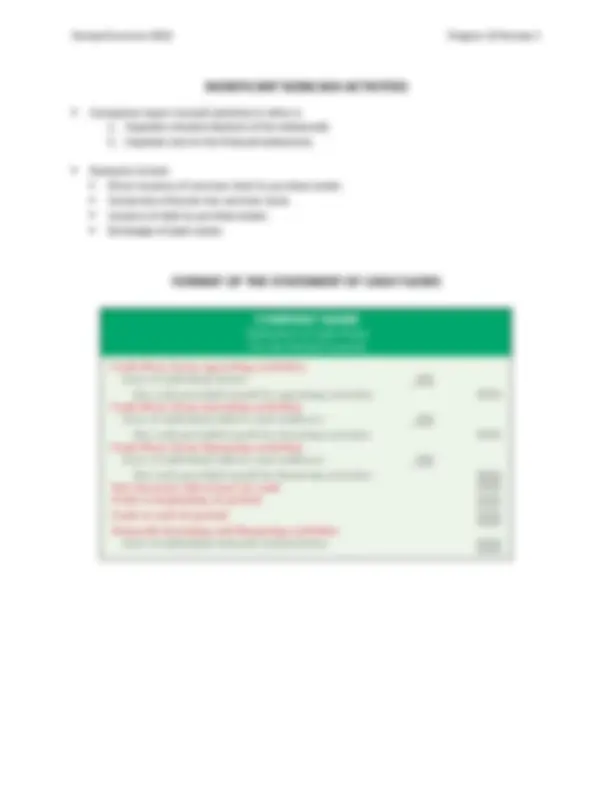
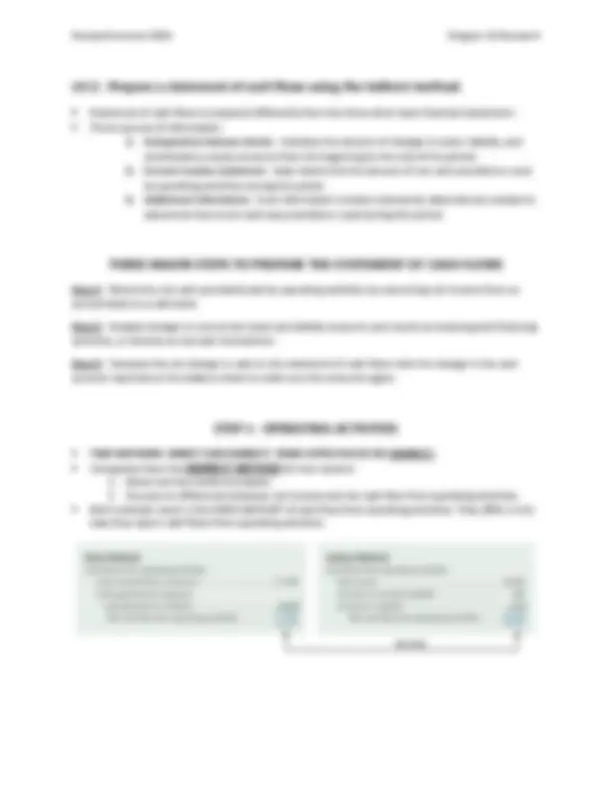
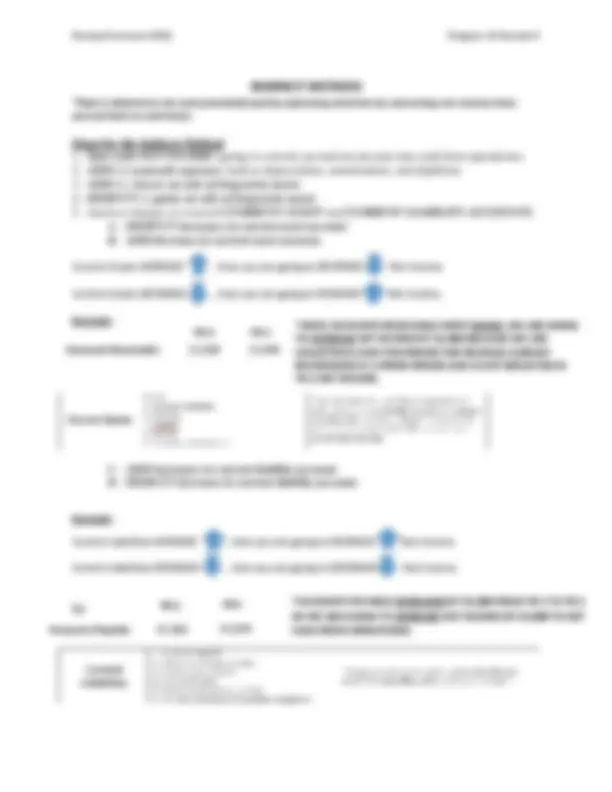
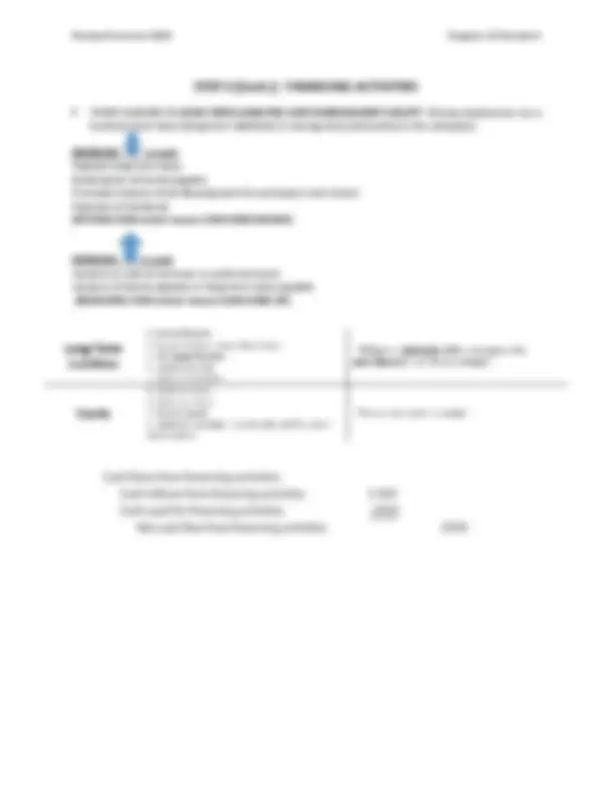
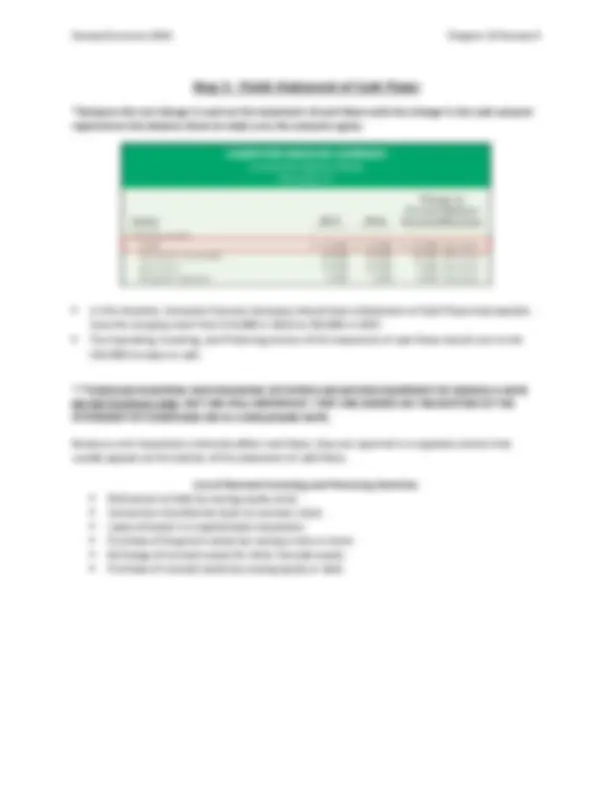
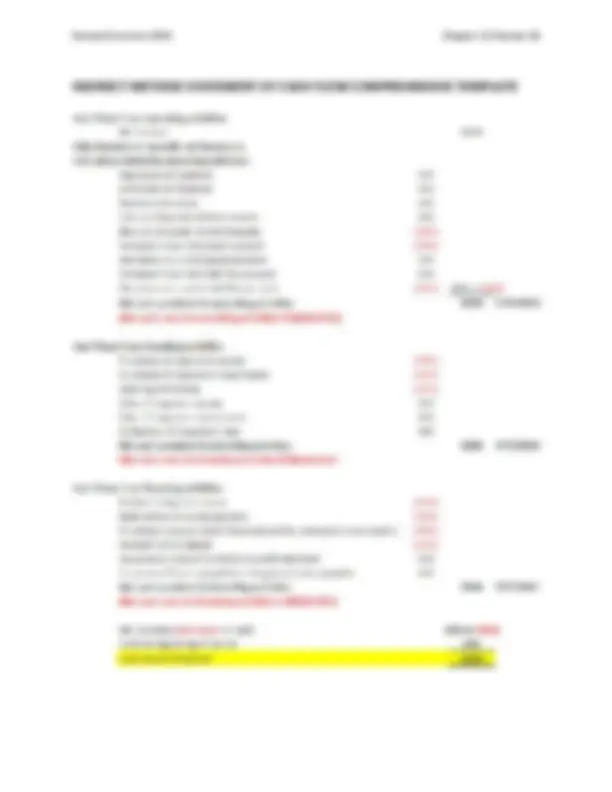
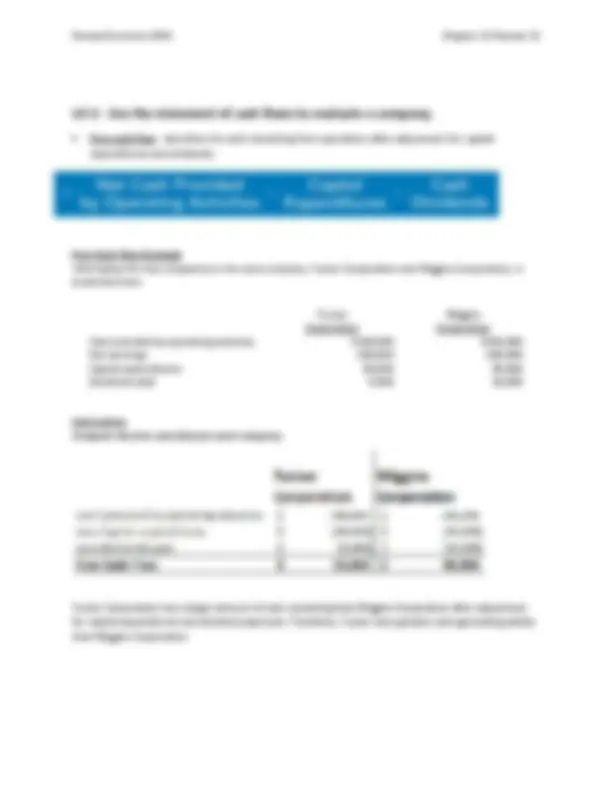



Study with the several resources on Docsity

Earn points by helping other students or get them with a premium plan


Prepare for your exams
Study with the several resources on Docsity

Earn points to download
Earn points by helping other students or get them with a premium plan
Community
Ask the community for help and clear up your study doubts
Discover the best universities in your country according to Docsity users
Free resources
Download our free guides on studying techniques, anxiety management strategies, and thesis advice from Docsity tutors
An in-depth review of Chapter 12 from a financial accounting course, focusing on the Statement of Cash Flows. Topics include the usefulness and format of the statement, the indirect method for preparing it, and examples of its application. Students will learn about operating, investing, and financing activities, as well as the importance of reconciling net income to net cash provided by operating activities.
What you will learn
Typology: Study notes
1 / 14

This page cannot be seen from the preview
Don't miss anything!









Statement of Cash Flows: reports the cash receipts and cash payments from operating, investing, and financing activities during a period. Provides information to help assess:
Cash inflows : From sale of goods or services. From interest received and dividends received. Cash outflows : To suppliers for inventory. To employees for wages. To government for taxes. To lenders for interest. To others for expenses.
a. The purchase or disposal of investments and property, plant, and equipment. b. Lending money and collecting the loans.
Cash inflows: From sale of property, plant, and equipment. From sale of investments in debt or equity securities of other entities. From collection of principal on loans to other entities. Cash outflows: To purchase property, plant, and equipment. To purchase investments in debt or equity securities of other entities. To make loans to other entities.
a. Obtaining cash from issuing debt and repaying the amounts borrowed. b. Obtaining cash from stockholders, repurchasing shares, and paying dividends.
Cash inflows : From sale of common stock. From issuance of debt (bonds and notes). Cash outflows: To stockholders as dividends. To redeem long-term debt or reacquire capital stock (treasury stock).
LO 2: Prepare a statement of cash flows using the indirect method. Statement of cash flows is prepared differently from the three other basic financial statements. Three sources of information:
1. Comparative balance sheets : indicates the amount of changes in asset, liability, and stockholders; equity accounts from the beginning to the end of the period. 2. Current income statement: helps determine the amount of net cash provided or used by operating activities during the period. 3. Additional information: Such information includes transaction data that are needed to determine how much cash was provided or used during the period. THREE MAJOR STEPS TO PREPARE THE STATEMENT OF CASH FLOWS Step 1: Determine net cash provided/used by operating activities by converting net income from an accrual basis to a cash basis. Step 2: Analyze changes in noncurrent asset and liability accounts and record as investing and financing activities, or disclose as noncash transactions. Step 3: Compare the net change in cash on the statement of cash flows with the change in the cash account reported on the balance sheet to make sure the amounts agree. STEP 1: OPERATING ACTIVITIES TWO METHODS: DIRECT AND INDIRECT. THESE NOTES FOCUS ON INDIRECT.
*INDIRECT METHOD Goal is determine net cash provided/used by operating activities by converting net income from accrual basis to cash basis.
Current Assets INCREASE , then you are going to DECREASE Net Income. Current Assets DECREASE , then you are going to INCREASE Net Income. Example :
Example : Current Liabilities INCREASE , then you are going to INCREASE Net Income. Current Liabilities DECREASE , then you are going to DECREASE Net Income. Ex) YR 2^ YR 1 Accounts Payable $7,000 $5,
Accounts Receivable
*STEP 2: INVESTING ACTIVITIES Analyze changes in noncurrent asset and liability accounts and record as investing and financing activities, or disclose as noncash transactions. THINK CHANGES IN NON-CURRENT (LONG-TERM) ASSETS (Property, plant, equipment, investments in stocks or bonds of other entities, loans to other entities, and collection of a nontrade receivable (EXCLUDING interest)) DECREASE in cash Purchase of long-term assets (Ex: buildings, equipment, land) Purchase of long-term investments Lending money ( PAYING CASH which means CASH GOES DOWN) INCREASE in cash Sale of long-term assets (Ex: buildings, equipment, land) Sale of long-term investments Collection of long-term loan **(RECEIVING CASH which means CASH GOES UP) *BE CAREFUL ……Sell Equipment for $2,000 with a $50 GAIN. *Equipment sold for $2,000 is shown as an INCREASE in cash in the Investing section and the $ GAIN is a DECREASE in the Operating section.
STEP 2 (Cont.): FINANCING ACTIVITIES THINK CHANGES IN LONG-TERM LIABILTIES AND SHAREHOLDER’S EQUITY. Money obtained to run a business from loans (long-term liabilities) or issuing stock (ownership in the company.) DECREASE in cash Payback long-term loans Redemption of bonds payable Purchase treasury stock (Buying back the company’s own stock.) Payment of dividends ( PAYING CASH which means CASH GOES DOWN) INCREASE in cash Issuance or sale of common or preferred stock Issuance of bonds payable or long-term notes payable (RECEIVING CASH which means CASH GOES UP)
INDIRECT METHOD STATEMENT OF CASH FLOW COMPREHENSIVE TEMPLATE
INDIRECT METHOD STATEMENT OF CASH FLOW COMPREHENSIVE EXAMPLE The following information is available for Magic Corporation for the year ended December 31, 20X7: Collection of principal on long-term loan to a supplier $16, Acquisition of equipment for cash 10, Proceeds from the sale of long-term investment at book value 22, Issuance of common stock for cash 20, Depreciation expense 25, Redemption of bonds payable at carrying (book) value 34, Payment of cash dividends 6, Net income 30, Purchase of land by issuing bonds payable 40, In addition, the following information is available from the comparative balance sheet for Magic at the end of 20X7 and 20X6: 20 X7 20 X Cash $148,000 $91, Accounts receivable (net) 25,000 15, Prepaid insurance 19,000 13, Total current assets $192,000 $119, Accounts payable $ 30,000 $19, Salaries and wages payable 6,000 7, Total current liabilities $ 36,000 $26, Instructions Prepare Magic’s statement of cash flows for the year ended December 31, 20X7, using the indirect method. ***Objective of the statement of cash flow will be to explain how cash increased by $57,000 from $91,000 in 20X6 to $148,000 in 20X7. The next page shows the solution to the problem. Notice that the cash from operating, investing, and financing activities sum up to that $57,000 difference in cash. Also, the sum of cash from operating, investing, and financing activities + beginning cash equal the current year’s cash balance on the balance sheet. This shows how the financial statements are interrelated.
LO 3: Use the statement of cash flows to evaluate a company. Free cash flow : describes the cash remaining from operations after adjustment for capital expenditures and dividends. Free Cash Flow Example Information for two companies in the same industry, Tucker Corporation and Wiggins Corporation, is presented here. Instructions Compute the free cash flow for each company. Tucker Corporation has a larger amount of cash remaining than Wiggins Corporation after adjustment for capital expenditures and dividend payments. Therefore, Tucker has a greater cash-generating ability than Wiggins Corporation. Tucker Wiggins Corporation Corporation Cash provided by operating activities $140,000 $140, Net earnings 200,000 200, Capital expenditures 60,000 90, Dividends paid 5,000 10,